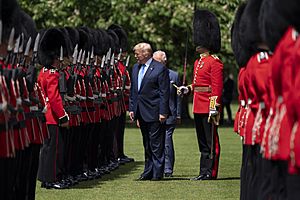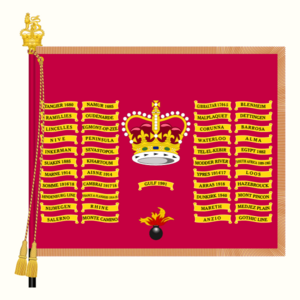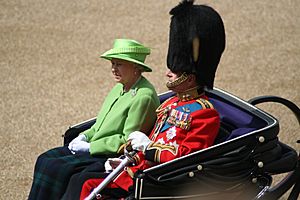Grenadier Guards facts for kids
Quick facts for kids Grenadier Guards |
|
|---|---|

Regimental badge of the Grenadier Guards since 6 May 2023
|
|
| Active | 1656–present |
| Country | Kingdom of England (1660–1707) Kingdom of Great Britain (1707–1800) United Kingdom (1801–present) |
| Branch | British Army |
| Type | Infantry |
| Role | 1st Battalion – Light Infantry/Public Duties Nijmegen Company – Public Duties |
| Size | One battalion – 558 personnel One independent company One reserve company |
| Part of | Guards Division |
| Garrison/HQ | RHQ – London 1st Battalion – Aldershot Nijmegen Company – London Ypres Company – Kingston upon Thames |
| Nickname(s) | The Tow-Rows The Coalers |
| Motto(s) | French: Honi soit qui mal y pense "Shamed be whoever thinks ill of it." |
| March | Quick: "The British Grenadiers" Slow: "Scipio" |
| Engagements | Oudenarde Waterloo Alma Inkerman Sevastopol Omdurman Ypres Battle of the Bulge Cyprus Emergency |
| Commanders | |
| Colonel-in-Chief | The King |
| Colonel of the Regiment | The Queen |
| Insignia | |
| Tactical recognition flash |  |
| Plume | White Left side of bearskin cap |
| Collar badge | Grenade |
| Shoulder badge | Royal Cypher |
| Abbreviation | GREN GDS |
The Grenadier Guards (GREN GDS) is a very old and important infantry regiment in the British Army. It's considered the most senior infantry regiment. Its history goes all the way back to 1656. That's when a group called Lord Wentworth's Regiment was formed in Bruges. Their job was to protect Charles II when he was living away from England.
In 1665, this group joined with another called John Russell's Regiment of Guards. Together, they became the regiment we know today. It was first called the 1st Regiment of Foot Guards. Since then, the Grenadier Guards have had two main jobs. They perform important ceremonies and protect important people. They also serve as soldiers in real battles.
Over the years, the regiment helped create other famous Guards regiments. In 1900, they helped form the Irish Guards. Later, in 1915, they also helped start the Welsh Guards.
The Grenadier Guards have fought in many wars throughout history. These include the War of the Spanish Succession, the Seven Years' War, and the Napoleonic Wars. After the Napoleonic Wars, they were given the special name "Grenadier." During the time of Queen Victoria, they fought in the Crimean War and the Second Boer War.
In the First World War, the regiment grew from three groups (battalions) to five. Four of these fought on the Western Front. During the Second World War, they had six battalions. Some even used tanks as part of the Guards Armoured Division. These units fought in France, North-West Europe, North Africa, and Italy.
After the Second World War, the regiment became smaller. Today, it has one main battalion. They have been sent to places like Palestine, Malaya, Cyprus, Northern Ireland, the Gulf War, Afghanistan, and Iraq.
Contents
The History of the Grenadier Guards
The Grenadier Guards started in 1656. Lord Wentworth's Regiment was formed by Prince Charles. He later became King Charles II. This group was his personal bodyguard in Bruges, Belgium. A few years later, another group, John Russell's Regiment of Guards, was created.
In 1665, these two groups joined together. They formed the 1st Regiment of Foot Guards. It had 24 groups of soldiers called companies. Since then, the Grenadier Guards have served many Kings and Queens. This includes Queen Elizabeth II.
Throughout the 1700s, the regiment fought in many wars. These included the War of Spanish Succession and the Seven Years' War. After the Napoleonic Wars in 1815, the regiment was officially named "Grenadier." This was a special honor from the King.
During the Victorian era, the regiment fought in the Crimean War. They were involved in battles at the Alma river, Inkerman, and Sevastopol. Four soldiers from the 3rd Battalion won the Victoria Cross for their bravery in this war.
Later, they fought in the Anglo-Egyptian War in 1882. They also fought in the Mahdist War in Sudan in 1885 and 1898. During the Second Boer War, two of their battalions went to South Africa. They fought in battles like Battle of Modder River and Belmont. In 1900, 75 men from the regiment helped start the Irish Guards. This honored the Irish soldiers who fought bravely in South Africa.
The Grenadier Guards in World War I
When the First World War began in August 1914, the regiment had three battalions. They quickly formed a fourth battalion and a reserve battalion. The reserve battalion stayed in London for ceremonial duties.
The 2nd Battalion went to France in August 1914. The 1st Battalion followed to Belgium in October. They fought in the early parts of the war, including the First Battle of Ypres. In February 1915, the Welsh Guards regiment was formed. The Grenadier Guards sent five officers and 634 soldiers to help start this new unit.
Soon after, the Guards Division was created. This division included the four service battalions of the Grenadier Guards. They fought in many major battles. These included Loos, the Somme, and Cambrai. Seven members of the regiment earned the Victoria Cross during this war.
After the war ended in November 1918, the regiment returned to having three battalions. They served in the United Kingdom, France, Turkey, and Egypt.
The Grenadier Guards in World War II
During the Second World War, the regiment grew to six battalions. The 4th, 5th, and 6th Battalions were added. The first three regular battalions went to France in late 1939. They were part of the British Expeditionary Force (BEF).
The 1st and 2nd Battalions were part of the 7th Guards Brigade. This brigade was in the 3rd Infantry Division. The 3rd Battalion was in the 1st Guards Brigade. It was part of the 1st Infantry Division. As the BEF was pushed back by the German army, these battalions helped keep the British Army's good reputation during the retreat. They were then evacuated from Dunkirk.
After returning to the UK, they prepared for a possible German invasion. Between 1940 and 1941, the 4th, 5th, and 6th Battalions were formed. In 1941, the army needed more tank and motorized units. So, the 2nd and 4th Battalions were given tanks. The 1st Battalion became motorized.
The 1st and 2nd (Armoured) Battalions were part of the Guards Armoured Division. The 4th Battalion was part of the 6th Guards Tank Brigade Group. They fought in North West Europe Campaign from 1944 to 1945. They took part in battles like Battle for Caen, Operation Market Garden, and the Battle of the Bulge.
The 3rd, 5th, and 6th Battalions fought in the North African Campaign. They also fought in the Italian Campaign. This included battles at Salerno, Anzio, and Monte Cassino. The 5th Battalion fought with the 1st Division at the Battle of Anzio. They had many casualties and were later relieved. The 6th Battalion was disbanded in late 1944 because there weren't enough replacement soldiers.
Two soldiers from the regiment won the Victoria Cross during the war. They were Lance Corporal Harry Nicholls and Major William Sidney.

The Grenadier Guards After World War II
After the war ended in June 1945, the 2nd and 4th Battalions stopped using tanks. They went back to being infantry. The regiment returned to having three battalions. The 4th, 5th, and 6th Battalions were disbanded.
At first, the regiment helped with occupation duties in Germany. However, the 3rd Battalion soon went to Palestine. They tried to keep the peace there until 1948. The 1st Battalion then took their place.
Later, they were sent to Malaya in 1949, Tripoli in 1951, and Cyprus in 1956. In 1960, the 3rd Battalion was put on hold. To keep its traditions alive, one of its companies, The Inkerman Company, joined the 1st Battalion.
Since the mid-1960s, the 1st and 2nd Battalions have served in Africa, South America, and Northern Ireland. They worked on peacekeeping missions. They also served with NATO forces in Germany during the Cold War. In 1991, the 1st Battalion went to the Middle East for the Persian Gulf War. They used Warrior armored vehicles. After that, they had a six-month tour in Northern Ireland.
The Grenadier Guards in the 21st Century
In 2002, the 1st Battalion was sent to Afghanistan as part of Operation Herrick. In 2003, they went to Iraq for Operation Telic.
As of 2014, new recruits for the Guards Division go through a tough 30-week training program. This is two weeks longer than for other British Army regiments. The extra time is spent on special drills and ceremonies.
In 2020, during the COVID-19 pandemic, members of the regiment helped the NHS. They assisted with COVID-19 testing and set up checkpoints in London.
Battle Honors and Achievements
The Grenadier Guards have earned 78 battle honours. These are special awards for their bravery and service in many conflicts. Some of these include:
- The War of the Spanish Succession (1701–1714), including the Battle of Oudenarde.
- The War of the Austrian Succession (1740–1748).
- The Napoleonic Wars, including the Peninsular War (1808–1814) and the famous Battle of Waterloo (1815).
- The Crimean War (1854–1855).
- The Egyptian War (1882).
- The Sudan Campaigns of 1885 and 1898.
- The Second Boer War (1889–1902).
- The First World War (1914–1918) on the Western Front.
- The Second World War (1939–1945) in North Africa, Italy, and Northwest Europe.
- The Persian Gulf War (1990–1991).
How the Regiment is Organized
In 1994, the Grenadier Guards became a single battalion. This was due to army changes. The 2nd Battalion was put on hold. Its special flags, called colours, were given to a new independent company. This company was named "Nijmegen Company."
So, the regiment now has one main battalion, the 1st Battalion. It has three rifle companies: The King's Company, No. 2 Company, and The Inkerman Company. It also has a support company and a headquarters company. There is also the independent Nijmegen Company, based in London. The Queen presented new colours to Nijmegen Company in 2013.
Recently, another company, Ypres Company, joined the Grenadier Guards. It is based in Kingston upon Thames.
The King's Company
The King's Company (or Queen's Company when the monarch is female) is the most important ceremonial unit of the regiment. It is one of the oldest groups of soldiers in the Army. They traditionally carry the coffin for all deceased monarchs. They also had a special role in the Coronation of Charles III and Camilla. All soldiers in this company must be over six feet tall.
The King is the Company Commander of the King's Company. A special officer called the "Captain-Lieutenant" manages the company daily. The company's Royal Standard is a special flag given by the monarch. It is only paraded when the King or Queen is present. King Charles II gave the first Colour to the company in 1656. Every monarch since then has given their own Royal Standard once during their reign. In April 2023, King Charles III presented a new Royal Standard to the King’s Company.
Colonels-in-Chief
The Colonels-in-Chief of the Grenadier Guards are usually the British monarchs. This includes Kings like Edward VII, George V, Edward VIII, George VI, and Charles III. Queen Elizabeth II was also a Colonel-in-Chief.
Regimental Colonels
Here is a list of important people who have been the Colonel of the regiment:
- Thomas Wentworth, 5th Baron Wentworth (1656)
- Hon. John Russell (1660)
- Henry Fitzroy, 1st Duke of Grafton (1681)
- Edward Lee, 1st Earl of Lichfield (1688)
- Henry Fitzroy, 1st Duke of Grafton (1688)
- Henry Sydney, 1st Earl of Romney (1689)
- Charles Schomberg, 2nd Duke of Schomberg (1690)
- Henry Sydney, 1st Earl of Romney (1693)
- John Churchill, 1st Duke of Marlborough (1704)
- James Butler, 2nd Duke of Ormonde (1712)
- John Churchill, 1st Duke of Marlborough (1714)
- William Cadogan, 1st Earl Cadogan (1722)
- Sir Charles Wills (1726)
- Prince William, Duke of Cumberland (1742)
- John Ligonier, 1st Earl Ligonier (1757)
- Prince William Henry, Duke of Gloucester and Edinburgh (1770)
- Prince Frederick, Duke of York and Albany (1805)
- Arthur Wellesley, 1st Duke of Wellington (1827)
- Albert, Prince Consort (1852)
- Prince George, Duke of Cambridge (1861)
- Prince Arthur, Duke of Connaught and Strathearn (1904)
- Princess Elizabeth (1942)
- George Jeffreys, 1st Baron Jeffreys (1952)
- Sir Allan Henry Shafto Adair (1960)
- Prince Philip, Duke of Edinburgh (1975)
- Prince Andrew, Duke of York (2017)
- Queen Camilla (2022)
Regimental Marches
The Grenadier Guards have two main marches. Their slow march is called "Scipio." It comes from an opera by George Frideric Handel. Handel actually wrote this march for the First Guards before putting it in his opera. Their quick march is called "The British Grenadiers."
Uniform
The Grenadier Guards wear a special full dress uniform for ceremonies. This uniform includes a very tall and heavy fur cap called a bearskin.
Alliances and Connections
The Grenadier Guards have special connections with other military units and organizations:
 Royal Navy – HMS Queen Elizabeth (a Royal Navy aircraft carrier)
Royal Navy – HMS Queen Elizabeth (a Royal Navy aircraft carrier) Canada – The Canadian Grenadier Guards (a Canadian Army regiment)
Canada – The Canadian Grenadier Guards (a Canadian Army regiment) Australia – 1st Battalion, Royal Australian Regiment (an Australian Army battalion)
Australia – 1st Battalion, Royal Australian Regiment (an Australian Army battalion) City of London – Worshipful Company of Ironmongers (a historic London guild)
City of London – Worshipful Company of Ironmongers (a historic London guild)
Regimental Lineage
| How the Regiment Began | |
| 1st Regiment of Foot Guards (later Grenadier Guards) |
The Royal Regiment of Guards |
| John Russell's Regiment of Guards | |
Order of Importance
The Grenadier Guards are the most senior infantry regiment in the British Army. This means they are at the very top of the list when it comes to importance among infantry units.
| Preceded by First in Order of Precedence |
Infantry Order of Precedence | Succeeded by Coldstream Guards |
See also
- James Ashworth
- George Higginson
- Military history of the United Kingdom
- British Army
- Canadian Grenadier Guards







